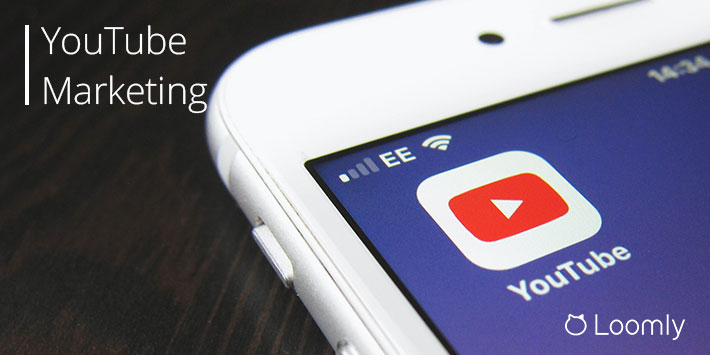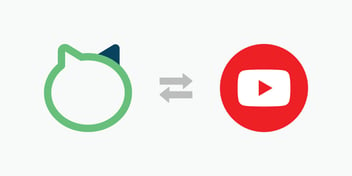YouTube Marketing FAQ
YouTube is the second largest search engine and the second most visited site on the Internet. It’s popular across different countries and age groups, and features a diverse range of content.
But you’re probably wondering if YouTube is any good for marketing? And if so, how do you implement a YouTube marketing strategy?
Stay tuned as the Loomly Team answers these and more YouTube marketing questions.
TABLE OF CONTENTS
What is YouTube marketing?
YouTube marketing is the practice of promoting brands and products on YouTube’s platform either by uploading valuable videos on your company’s YouTube channel or using YouTube ads.
Should your brand care about YouTube?
If you’re thinking of starting to use video for your brand, or you’re already creating video content, then you can’t afford to ignore YouTube, as it’s the best social video channel.
Of course, video is also popular on other social channels like TikTok, Instagram, and Facebook, but YouTube has the edge.
It’s second only to Google as the most visited site on the internet and has its own powerful search engine so that users can easily find specific content.
In short, it’s a social media giant with endless opportunities for brands.
Is YouTube good for marketing?
YouTube is an essential marketing tool for practically any brand in any industry. Here are three reasons why you should be marketing on YouTube:
- Create brand authority. Video marketing can help to build trust and establish brand authority. Moreover, it makes it easier to connect and engage with customers.
- Build credibility and trust. As a brand, trust is everything when it comes to customer acquisition. By uploading content on YouTube, you can let customers view and evaluate your services and products. For example, you could upload a video with information steps or instructions to help your target viewers accomplish a set of tasks or actions. Another way to build trust and credibility is to upload videos showing customer engagement and recommendations of your product.
- Engage your audience. Videos are a great way to connect with your viewers and provide a more personal, hands-on feel than traditional marketing channels. YouTube offers marketers several different ways to engage their audience. For example, viewers can leave feedback and comments on the videos, so they can interact with each other and also with the company.
Does YouTube marketing work?
In a word: YES.
YouTube marketing works throughout the sales funnel.
Top and Middle of the Funnel Video:
YouTube’s strengths—ease of consumption, emotional impact, and viral potential—make it an ideal medium for the top and middle of the funnel. Short films, webinars, how-to videos, and other informational video content can all be great tools for raising awareness and improving the perception of your brand.
Bottom of the Funnel Video:
According to animated explainer company Wyzowl, video marketing does well at driving conversions as well as awareness:
- 64% of businesses who use video believe that it has directly led to increased sales conversions.
- 78% of video marketers say video has directly helped increase sales.
How do you implement a successful YouTube marketing strategy?
Follow these five steps to implement a successful YouTube marketing strategy for your brand:
- Step 1 – Brand your channel. Make sure you keep your YouTube channel branding consistent with your other social media accounts, including:
- Colors
- Name
- Icon (Logo or Photo)
- Art
- Description
- Trailer
- Custom URL
- Links
- Step 2 – Create your content. Create and publish video content consistently to build your presence on the platform. Here are eleven types of video content to consider using on your channel:
- Step 3 – Optimize your content. Optimize your video content to maximize YouTube SEO and match search intent:
- Title
- Description
- Tags
- Category
- Thumbnails
- SRT files (Subtitles and Closed Captions)
- Cards and End Screens
- Calls-to-action
- Step 4 – Promote your content. Here are six ways to promote your YouTube videos:
- Share on other social media platforms
- Embed on your website
- Email your subscribers
- Cross-promote with other YouTube channels
- Collaborate with influencers
- Engage with your audience
- Step 5 – Analyze your results. Analyze your YouTube marketing performance to see where you can improve:
- Evaluate your goals and KPIs
How do you become a YouTube marketer?
These YouTube Marketing Tips from HubSpot might work better:
- Set a publishing schedule and stick to it.
Inconsistency is one of the biggest mistakes new YouTubers make when they start their channel. It’s better to post one video each month rather than publishing a video every week, then taking an unexpected break of two weeks.
- Allow for the upfront investment for publishing video.
No matter how you choose to produce videos, you’ll need to make an upfront investment before you publish your first video. Digital information estimates the cost of DIY YouTube production may range from about $1,300 to $10,000.
- Keep your revenue expectations reasonable for the first year.
It’s widely known that YouTube channels receive 68% of AdSense revenue from Google once they’ve generated enough traffic to bring in views consistently. That’s the key to building a YouTube channel – you may not make much money on your first few videos, but being consistent can be lucrative in the long run.
How much does YouTube marketing cost?
The cost of YouTube ads depends on a few factors, including watch time, audience targeting, and campaign objective.
On average, though, YouTube advertising costs are $0.10 to $0.30 per view or action, with an average daily budget of $10. That means every time someone views your ad or engages with your ad, like by clicking on a call-to-action, you pay around $0.10 to $0.30.

Manage all your social media accounts in one place.
Craft, schedule, & auto-post content to all your social channels, then track analytics and manage interactions from a single, easy-to-use dashboard.
YouTube Marketing FAQ in a Nutshell
Video is huge right now. And YouTube is the best platform to build your video marketing strategy. Follow the tips above to get your YouTube marketing off the ground.



